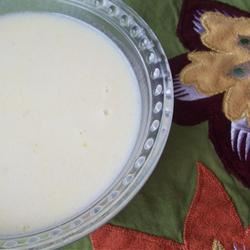Cream Soup Base

This is a creamy soup base that will make many types of cream soup. Use your imagination and create a new soup.
INGRIDIENT
DIRECTION
Step: 1
Melt butter in a saucepan. Add flour and make a paste. Add milk and bouillon cubes. Cook over low heat until thickened. Add pepper to taste. Add more milk when adding the other soup ingredients, depending on the thickness you desire.
Step: 2
To this base you may add steamed broccoli and American cheese; or chunks of baked potato (peel and all) with American cheese, bacon pieces, and chives; or pureed, stewed tomatoes for a bisque; or leeks that have been cleaned well, steamed, and chopped; or cooked asparagus cut in pieces (if canned asparagus is used, add some of the liquid as well), topped with grated cheese and bacon pieces.
NUTRITION FACT
Per Serving: 156 calories; protein 2.9g; carbohydrates 7.6g; fat 12.8g; cholesterol 35.5mg; sodium 394.8mg.
The name of “stew” can process to 2 time a food and a make dishes method. Stewing involves not fast cooking chunks of meat, vegetables or beans in a flavorful liquid . It’s same as to braising, but it makes have a few notable differences. The raw animal vested is chopped into few of pieces instead of being cooked all of it , and the water based material completely covers the contents in a stew as different to a braise’s halfway all of it . When meat or vegetables are cooked using this method, the resulting dish is called stew.
Stew has a reputation for being a rib-sticking meal that comfortable you up on a freezing , winter day. It’s true ; a bowl of classic beef stew does have warming properties , but stew’s comfort factor more than a way beyond preserving you from the cold . It’s all about those tender chunks of food and vegetables, swimming in a thick, ultra-rich gravy. The way they come together make the ultimate comfort food, no matter the weather.





